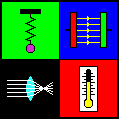|
This simulation shows two pendula coupled by a spring which has a small spring constant (weak coupling). For such systems it is characteristic that the oscillation's energy permanently moves from one partial system to the other.
The "Reset" button brings the system to its initial position. You can start or stop and continue the simulation with the other two buttons. If you choose the option "Slow motion", the movement will be five times slower. It is possible to change the initial positions of the two pendula by using the corresponding text fields. A positive (negative) angle means an elongation to the right (left) side.
You can get the harmonics of the system as follows:
| If you write two equal numbers into the text fields (e.g. twice 10°), the two pendula will always have same phases. | |
| By choosing two opposite numbers (e.g. 8° and -8°), you can get an oscillation with opposite phases. |
If you write 0° into one of the text fields for the initial positions, the entire energy of the oscillation will alternately be transferred to one of the pendula: That pendulum which first was in the mid-position oscillates with an ever-increasing amplitude, whereas the amplitude of the other pendulum decreases. After some time there is a moment in which only the first-mentioned pendulum oscillates; the other one stops in the mid-position at that time. Afterwards this process happens again with reversed roles and so on.
![]()
 |
| Physics Applets (Overview) |
URL: http://home.a-city.de/walter.fendt/phe/cpendula.htm
© Walter Fendt, July 5, 1998
Last modification: December 20, 1999